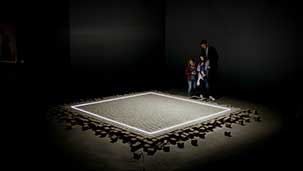As you know, Andy Warhol famously didn’t play the fool when it came to separating art and commerce. “Making money is art and working is art and good business is the best art,” he’s quoted with saying. You’d think his naked ambition would have signalled the death of the art gallery industrial complex. Instead, the value of Warhol’s work has only ever soared and is still considered a “bellwether of the art market”. Even today, pop art disciple Damien Hirst makes over $100M annually by bypassing the gallery game altogether. Yet the crusty culture of institutionally inflated art prices continue to prosper nearly unfettered.
Really, has there ever been a more apt target to satirize?
Ruben Östlund’s latest film, of course, isn’t trying to take the piss out of artists themselves. Not entirely, anyway. People like you working their way up the art department ranks are absolutely essential to why his vision in The Square comes to life so exquisitely, both adoring and abhorring the world of contemporary art museums. The attention given to the film’s art direction and careful framing of each shot, combined with the petulant nonsense that happens within it, is what accentuates his theme in ways the narrative never has to.
Except, of course, when it does. The film opens with a simple question: if a common object, like the purse of Elizabeth Moss (who plays a naive art journalist) is placed in a gallery, does the space suddenly imbue the object with new meaning? Does it become art? It’s a bit of a philosophical wank, especially the way it’s posed with such convoluted rhetoric in the film. Moss’ confused/differential shrug offers about as satisfactory of an answer as one could hope for, and one that crystallizes everything right with The Square.
In the same way Östlund handily tore masculinity a new one in Force Majeure, his ability to undermine what’s revered about fine art galleries comes in sneaky waves. Focusing on the actions of a museum curator in Sweden, the film builds up a series of events that only ever get half pursued. We do get several scenes where he tries to find a pickpocket who robbed him of his wallet (and, more importantly, his moment of heroism), but other threads, both comedic and dramatic, are often left dangling rather than being fully indulged. Though he doesn’t spare a second of the extended anguish that occurs in the film’s nearly untelegraphed climax, where an artist agonizingly insists on intensifying his performance for a room of museum patrons. The scene could almost say as much completely out of context, but is of course greatly enriched for being included in the film (you know, like stuff in a gallery). And in this case, the artist also embodies all the confidence and defiance missing from the staid life of the museum’s curator.
But what to say of the film’s titular Square that frames at least some of the story’s inner pretension and ambition? As fun as that set piece may have been to make, I can’t help but think it was also the film’s most obvious red herring. So let’s not fall into the trap of over selling or analyzing its simple and silly significance.
Sincerely,

Christopher







